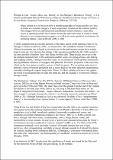Files in this item
Sound, music and memory in Jia Zhangke’s 'Hometown Trilogy'
Item metadata
| dc.contributor.author | Lovatt, Philippa | |
| dc.contributor.editor | Greene, Liz | |
| dc.contributor.editor | Kulezic-Wilson , Danijela | |
| dc.date.accessioned | 2019-04-01T10:30:07Z | |
| dc.date.available | 2019-04-01T10:30:07Z | |
| dc.date.issued | 2016-12 | |
| dc.identifier | 257641961 | |
| dc.identifier | dc231627-32c0-411f-98d9-e7c6261adfbe | |
| dc.identifier | 84973489192 | |
| dc.identifier.citation | Lovatt , P 2016 , Sound, music and memory in Jia Zhangke’s 'Hometown Trilogy' . in L Greene & D Kulezic-Wilson (eds) , Palgrave Handbook of Sound Design and Music in Screen Media : Integrated Soundtracks . Palgrave Macmillan , London , pp. 229-244 . https://doi.org/10.1057/978-1-137-51680-0_16 | en |
| dc.identifier.isbn | 9781137516794 | |
| dc.identifier.isbn | 9781137516800 | |
| dc.identifier.other | ORCID: /0000-0001-9369-8169/work/65014600 | |
| dc.identifier.uri | https://hdl.handle.net/10023/17409 | |
| dc.description.abstract | In the films of Jia Zhangke, the complex diegetic soundscapes are represented as ‘occupied’ spaces, articulating the dense layering of competing discourses in reform-era China and evoking acoustically the struggle of the subject to negotiate a space within them. Music is used in these films (both diegetic and non-diegetic) to communicate the passing of time as well as the characters’ changing attitudes from the end of the Cultural Revolution through to the early days of the reform era. This chapter analyses the use of sound and music in Jia Zhangke’s Hometown Trilogy in order to demonstrate how they can play a crucial role in articulating the shifting dynamics of social space, at the same time as communicating characters’ subjective experience of the passing of time. | |
| dc.format.extent | 16 | |
| dc.format.extent | 219396 | |
| dc.language.iso | eng | |
| dc.publisher | Palgrave Macmillan | |
| dc.relation.ispartof | Palgrave Handbook of Sound Design and Music in Screen Media | en |
| dc.subject | PN1993 Motion Pictures | en |
| dc.subject.lcc | PN1993 | en |
| dc.title | Sound, music and memory in Jia Zhangke’s 'Hometown Trilogy' | en |
| dc.type | Book item | en |
| dc.contributor.institution | University of St Andrews. Film Studies | en |
| dc.identifier.doi | https://doi.org/10.1057/978-1-137-51680-0_16 | |
| dc.date.embargoedUntil | 2018-12-16 | |
| dc.identifier.url | https://doi.org/10.1057/978-1-137-51680-0 | en |
This item appears in the following Collection(s)
Items in the St Andrews Research Repository are protected by copyright, with all rights reserved, unless otherwise indicated.

